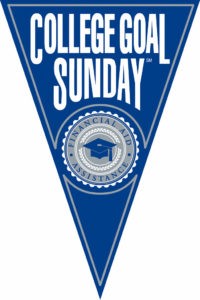 Overwhelming is a good way to describe what it’s like to send your child off to college. Maybe you’re sad (or happy, no judgement) to have them out of the nest and discovering their first taste of independence. Aside from hoping they go to class and get an education that can set them up for a bright future, there are dorms to furnish and long-term decisions to make.
Overwhelming is a good way to describe what it’s like to send your child off to college. Maybe you’re sad (or happy, no judgement) to have them out of the nest and discovering their first taste of independence. Aside from hoping they go to class and get an education that can set them up for a bright future, there are dorms to furnish and long-term decisions to make.
And all of that doesn’t include one of the most stressful aspects: how to pay for college.
One way to alleviate the stress of sorting through the financial aid process is by attending College Goal Sunday on November 5. Financial aid professionals will volunteer at 39 locations around the state to help students and families fill out the Free Application for Federal Student Aid (FAFSA). The document is required for students at most colleges and universities to be eligible for grants, scholarships and student loans.
While the FAFSA process can seem daunting or time consuming, students and families can fill out and file the form online in one afternoon with the help of professionals standing by.
College Goal Sunday is run by the Indiana Student Financial Aid Association (IFSAA) and is adding this November event in addition to its annual College Goal Sunday in February.
Interested? Here’s what you should bring:
- Students should attend with parents or guardians (unless students are age 24 or older)
- Parents should bring completed 2016 IRS 1040 tax returns, W-2 forms and other 2016 income and benefits information
- Students who worked the previous year should bring their income information
- Students age 24 and older should bring their own completed 2016 IRS 1040 tax return, W-2 Form or other 2016 income and benefits information
- Students and parents are encouraged to apply for U.S. Department of Education FSA IDs at ed.gov before attending the event
A complete list of sites is available at CollegeGoalSunday.org. All sites will have online capabilities and many will offer Spanish language interpreters. Students who attend and fill out a completed evaluation will also be entered to win one of five $1,000 scholarships.

 More than 200 new state laws went into effect today. Unless you like to throw caution to the wind – which is not known as a wise tactic in the face of law enforcement – it’s a good idea to take note of what’s now on your to-do and to-don’t lists. Below are a few examples.
More than 200 new state laws went into effect today. Unless you like to throw caution to the wind – which is not known as a wise tactic in the face of law enforcement – it’s a good idea to take note of what’s now on your to-do and to-don’t lists. Below are a few examples. Oh, California. You gave us good wine, the Grateful Dead, and Reggie Miller. We should probably be a little kinder to you than we are. But you don’t make it easy. The
Oh, California. You gave us good wine, the Grateful Dead, and Reggie Miller. We should probably be a little kinder to you than we are. But you don’t make it easy. The  HOPE, "Bright Futures" and "Promise" are the names of three state-based college scholarship programs intended to expand higher education opportunities. Each effort, along with those in other states, may fall victim (at least in part) to a series of fiscal challenges.
HOPE, "Bright Futures" and "Promise" are the names of three state-based college scholarship programs intended to expand higher education opportunities. Each effort, along with those in other states, may fall victim (at least in part) to a series of fiscal challenges.